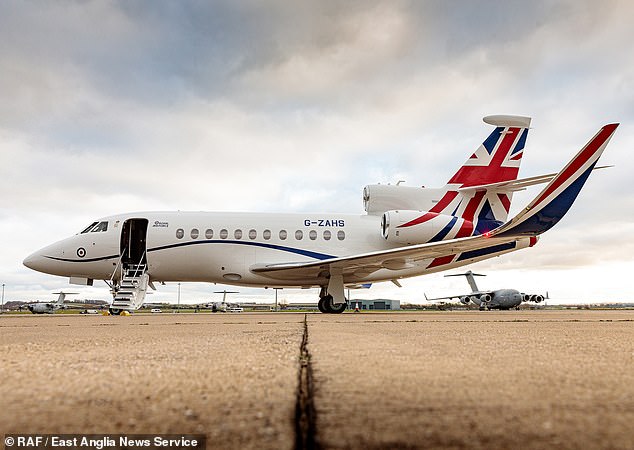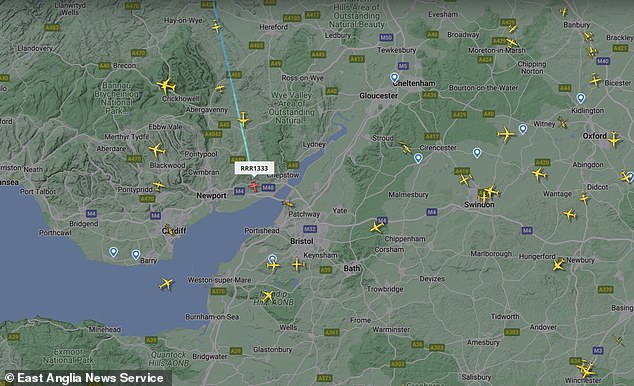EXCLUSIVE: RAF jet used by royals including Kate and William came within 30 feet of smashing into an illegally-flown drone at 260mph
An RAF aircraft used to transport members of the royal family and ministers came within 30 feet of a collision with an illegally flown drone, a report has found.
It happened in the nick of time when the twin-engined Envoy IV aircraft of the RAF’s No. 32 (The Royal) Squadron landed at Bristol Airport after a flight from Edinburgh.
Flight Tracker data shows that the private jet-style aircraft, which can carry 14 passengers, was traveling at about 260 mph when the near miss occurred at an altitude of 9,700 feet.
The Royal Squadron’s Envoy IV jets are described on the RAF website as ‘playing a critical role in defense diplomacy’ and used to ‘carry members of the royal family, heads of government and military leaders’.
Buckingham Palace has refused to confirm or deny whether any Royals were on board the plane at the time and the RAF said it could not comment on the identities of the passengers.
A plane that carried the Prince and Princess of Wales to a royal wedding in Jordan three weeks ago (pictured) came within just 30 feet of colliding with an illegally flown drone
Records from the Court Circular show that on the day of the incident on June 21 this year, no members of the royal family had official engagements in Bristol or Edinburgh, although some engagements are private and do not appear in official records.
But flight records show that the same plane was used just three weeks earlier to ferry the Prince and Princess of Wales to and from Jordan for the wedding of King Abdullah’s eldest son, Crown Prince al Hussein.
A UK Airprox Board report, which assesses near misses in UK airspace, assessed the drone near misses as a category A incident where there was a serious risk of collision.
The incident happened just after 7pm on June 21 this year, just north of the Severn Bridge,
The drone was flown at more than 24 times the normal legal height limit of 120 meters for the devices.
Most drones have software that limits flight altitude, but updates can be bought illegally over the internet to override this.
It is believed that some rogue drone operators supply their devices with extra batteries to try to fly as close to planes as possible and capture dramatic videos of them in flight.
But if they are caught and convicted of jeopardizing an aircraft, they risk a prison sentence of up to five years.

The twin-engine Envoy IV encountered the near miss while flying at 420 km/h at 9,700 feet
It is believed that the operator of the drone that threatened the royal aircraft has never been traced.
Pilots and aviation experts have repeatedly warned in recent years about the risks of drones colliding with passenger aircraft cockpit windows or engines.
The Envoy IV jet was one of two Dassault 900LX aircraft to join the Royal Squadron at RAF Northolt in March last year.
According to the UKAB report, the aircraft was about 18 miles from Bristol Airport when ‘a drone was sighted at the same level passing about 30 feet to the left’.
The report added: ‘The co-pilot saw the drone first, followed shortly by the captain. The drone was a quadcopter type, silver/white with red flashes and was immediately reported to Bristol Radar.’
In their report to the UKAB, the pilots rated the risk of a collision as ‘medium’.
The report read: ‘The Bristol controller reports that at about 6pm the pilot of the F900 reported that “a drone” had just passed close to the aircraft at 9700ft.
It was reported that the object was red and silver in color and was either a drone or a weather balloon. The object was reportedly about 30 feet away from the plane.
‘The pilot indicated that he would like to submit an Airprox. No other aircraft reported sighting the object in the vicinity within the next 30 minutes.”
The report concludes: ‘In the opinion of the Board, the reported description of the object was sufficient to indicate that it could be a drone.
“The Board was of the opinion that the general report of the incident by the pilot reflected a situation in which providence had played an important role in the incident and/or there had been a clear risk of collision.”

The incident occurred as the RAF aircraft was approaching Bristol Airport
A spokesperson for the RAF said: ‘The RAF regularly transports members of the Royal Family, ministers and military leaders in Britain and abroad.
“Drones operating near our aircraft can pose a significant threat to their safety and can be a huge challenge for our flight crews to detect and take action.
“We continue to encourage users to use their assets responsibly and legally, in compliance with CAA regulations.”
The RAF website states that the Royal Squadron’s two Envoy IV jets are currently being flown by mixed crews from the RAF and aeronautical services company Centreline.
It added: ‘Strengthening our international presence, deepening our current defense relationships and building new ones is critical to British security.
“The new Envoy aircraft will transport members of the royal family, government leaders and military leaders around the world faster and more efficiently than before. The Envoy can fly further, faster and more sustainably than the aircraft it replaces.”
A spokesman for Buckingham Palace said: “It is not for us to comment on that.”
